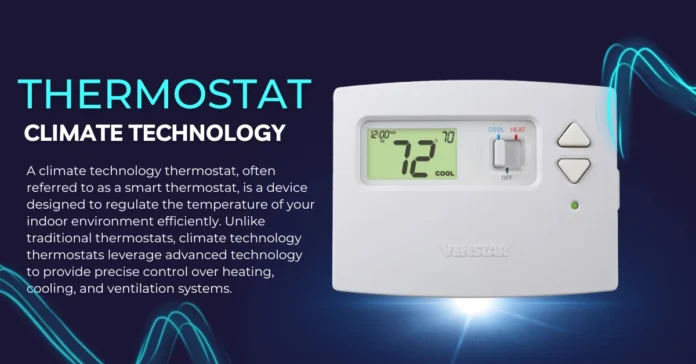In a time when climate change is a major world issue, it is very important to understand and control our indoor environment. A thermostat with temperature technology is a useful tool for this. This complete guide will explain what a climate technology thermostat is, how it works, what its benefits are, and how it affects how much energy you use.
Understanding Climate Technology Thermostat
What is a Climate Technology Thermostat?
A climate technology thermostat, often referred to as a smart thermostat, is a device designed to regulate the temperature of your indoor environment efficiently. Unlike traditional thermostats, climate technology thermostats leverage advanced technology to provide precise control over heating, cooling, and ventilation systems.
The Evolution of Thermostats
Thermostats have changed a lot over the years. From the early manual models to programmable thermostats, the evolution has been impressive. However, climate technology thermostats take this evolution to the next level by adding connectivity, artificial intelligence, and automation.
How Does Climate Technology Differ?
What sets climate technology thermostats apart is their ability to adapt and learn. These devices can analyze your preferences and usage patterns, creating a customized temperature schedule. They also offer remote access, allowing you to control your indoor climate from anywhere with an internet connection.
If you do not have this device so firstly you can buy thermostats from Amazon
Key Features of Climate Technology Thermostats

Remote Access and Control
Remote access is one of the best things about climate technology heaters. You can change the temperature in your home even when you’re not there with a specific app or web interface. This tool not only makes things easier, but it also helps save energy.
Skills for Learning
The thermostats that come with climate technology have machine-learning systems built in. They look at how you use them and what you like, then change the settings automatically to make sure your home is at the right temperature. As time goes on, these gadgets get better at controlling your climate.
Monitoring how much energy is used
These heaters give you information about how much energy you use. You can keep track of how much energy your heating and cooling systems are using. This makes it easier to find ways to use less energy and lower your utility bills.
The Mechanism at Work
Sensors and Getting Information
A lot of different devices are used in climate technology thermostats to gather information. These sensors track things like temperature, humidity, and how many people are in a room. The data is then used to make changes in real-time so that you stay at the level of comfort you want.
AI and Learning Machines
Artificial intelligence (AI) and machine learning are at the heart of climate change devices. These technologies take the collected data and use it to make programs that improve the performance of your HVAC system.
Adding Smart Features
A lot of climate technology thermostats work with other smart home devices, like blinds and lights. This makes it possible to automate your whole home, which improves both comfort and energy economy.
Benefits of Climate Technology Thermostats
Energy Efficiency
One of the primary benefits of climate technology thermostats is their impact on energy efficiency. By learning your preferences and optimizing your HVAC system’s performance, these thermostats can reduce energy consumption and lower your energy bills.
Cost Savings
The energy savings achieved with a climate technology thermostat can translate into significant cost savings over time. The initial investment is often outweighed by the reduced energy expenses.
Environmental Impact
Not only does using less energy save you money, it also lowers your carbon footprint. By wasting less energy, climate technology devices help make the future more sustainable.
Convenience and Comfort
With remote access and learning capabilities, these thermostats offer unparalleled convenience. You can enjoy a comfortable home environment without the need for manual adjustments.
How to Pick the Best Thermostat for Climate Technology
- Compatibility: Make sure that the climate technology thermostat you want to buy will work with your HVAC system before you buy it. Make sure it works with your heating, cooling, and ventilation systems to make sure the installation goes smoothly.
- User Interface: Think about how the thermostat’s user interface works. It is easier to set up schedules and make changes when the interface is easy to use.
Integration with Smart Home Systems
If you have other smart home devices, look for a thermostat that can integrate with your existing ecosystem for a more cohesive and automated home experience.
Setting up and installing things on your own

A lot of climate technology thermostats are made to be easy to put yourself. Usually, step-by-step directions are given, and the installation can be finished in an hour.
Installation by a Professional
If you aren’t sure how to do installations yourself or have a complicated HVAC system, it might be best to hire a professional to make sure everything is set up properly.
How to Use a Climate Technology Thermostat Correctly
- Setting Ideal Temperatures: To maximize the benefits of your climate technology thermostat, set ideal temperature ranges that align with your comfort preferences. These settings can vary based on the season, time of day, and your presence at home.
- Programming Schedules: Take advantage of the scheduling capabilities of your thermostat. Create a schedule that reflects your daily routine, adjusting temperature settings to conserve energy when you’re not at home and ensuring a comfortable environment when you are.
- Regular Maintenance: While climate technology thermostats are designed to be low-maintenance, it’s essential to perform regular check-ups. Ensure the thermostat’s sensors are clean and functioning correctly. Additionally, keep your HVAC system well-maintained to guarantee optimal performance.
Effects on how well energy is used
Cutting down on energy use
Being able to adjust temperatures to fit your needs and adapt to your habits greatly lowers the amount of energy you use. Climate technology thermostats are a good buy because they can cut your heating and cooling costs by up to 20%.
Getting rid of carbon footprint
By using less energy, climate technology devices help you leave less of a carbon footprint. By lowering greenhouse gas emissions, they are very important for protecting the earth.
Examples from real-life
Part 3 will have real-life examples and case studies that show how climate technology controls can be useful in different situations.
Typical Myths and False Ideas
Climate Technology Thermostats Are Expensive
While the initial cost may seem higher than traditional thermostats, the long-term cost savings in energy bills make climate technology thermostats a cost-effective choice.
Complicated to Use
Modern climate technology thermostats are designed to be user-friendly. Their learning capabilities minimize the need for constant adjustments, and most can be controlled via a smartphone app.
Privacy Concerns
Manufacturers prioritize user privacy, and data security is a significant focus. Your data is encrypted, and you have control over what information is shared.
Thermostats and the future of climate technology
- Connecting to Renewable Energy Sources: A cool new trend is for climate technology timers to work with clean energy sources like solar panels and wind turbines. This can help you depend less on traditional energy sources.
- Better capabilities for AI: In the future, climate technology thermostats will likely get even smarter, with AI that can better guess your tastes and the weather.
- Initiatives and rules from the government: Governments all over the world are pushing people to use tools that use less energy. Look for rules and rewards in your area that will help people use climate technology thermostats.
Success Stories
Residential Applications
Explore real-life examples of homeowners who have benefited from climate technology thermostats, sharing their stories and energy savings.
Commercial and Industrial Use
Learn how companies and industries are leveraging climate technology thermostats to improve energy efficiency, lower operational costs, and enhance workplace comfort.
Challenges and Concerns
- Cybersecurity: As is the case with any other device that is connected, there are security issues. In Part 4 of this guide, we’ll talk about the best ways to keep your climate technology thermostat safe.
- E-waste Management: Getting rid of old thermostats and other electronic waste is bad for the earth. Find out how to properly donate or get rid of old thermostats.
- User Dependency: Climate-technology timers are useful, but they can be too dependent on automation. We’ll talk about how to find the best mix between automation and control by hand.
Conclusion
Through this in-depth guide, we’ve looked into climate technology thermostats and looked at their features, benefits, and how they can help save energy. These smart thermostats do more than just control the temperature; they can also help make your home more comfy and energy-efficient.
With the help of AI, machine learning, and remote access, climate technology thermostats give you more control and ease than you could know before. They learn what you like, change based on your daily habits, and can even work with other smart home devices. That not only makes your life more comfortable, but it also helps save a lot of energy and protect the environment.
There are some myths and worries about these devices, but in general, they are easy to use, save you money in the long run, and put your safety first.
As climate technology thermostats keep getting better, we can expect even more exciting changes, like more ways to connect to green energy sources and better AI. Governments all over the world are realising how useful these devices are and are giving incentives to get people to use them.
Climate technology thermostats are useful for homes, companies, and industries in a world where saving energy and taking care of the environment is very important.
FAQs
1: What is the primary purpose of a climate technology thermostat?
A climate technology thermostat’s primary purpose is to efficiently regulate indoor temperatures, optimize energy consumption, and provide a comfortable environment.
2: Can a climate technology thermostat save me money on my energy bills?
Yes, climate technology thermostats can lead to significant savings on your energy bills by reducing energy consumption through intelligent control.
3: Are climate technology thermostats compatible with all HVAC systems?
Compatibility may vary, so it’s essential to check if a specific thermostat is compatible with your HVAC system. Most thermostats provide compatibility information in their product details.
4: How secure is the data collected by these thermostats?
Manufacturers prioritize data security and use encryption to protect user data. Users also have control over data sharing, adding an extra layer of privacy.
5: What does the future hold for climate technology thermostats?
The future of climate technology thermostats includes enhanced AI capabilities, increased integration with renewable energy sources, and continued support from government initiatives and regulations.
This concludes our comprehensive guide on climate technology thermostats. We hope it has provided valuable insights into this innovative technology and its potential to transform your indoor environment and reduce your carbon footprint.
Read More







